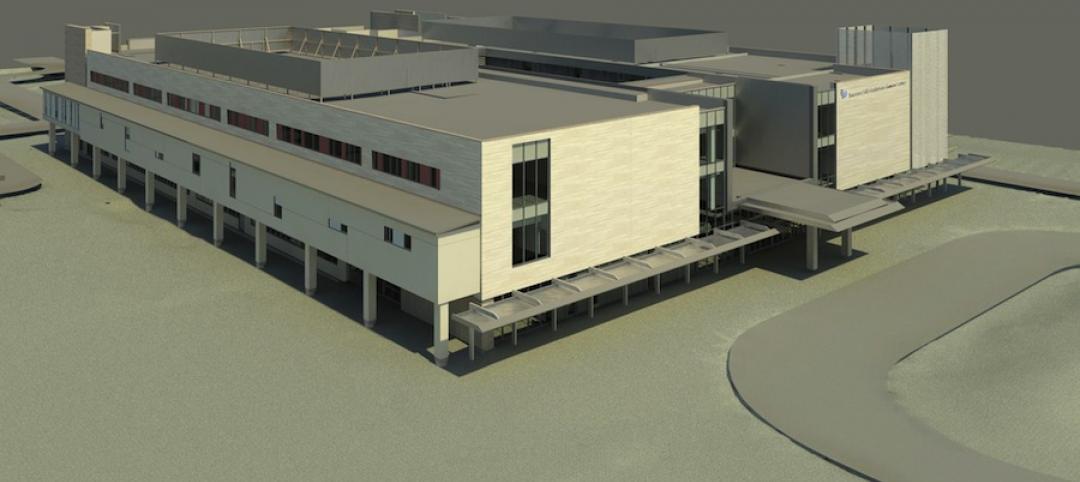Design-build and, to a somewhat lesser degree, Integrated Project Delivery (IPD) have become increasingly popular and common contract platforms for healthcare projects. These agreements promise greater efficiency and share the profit risk on new construction among developers, health systems, and AEC firms.
Add to that list of options Collaborative Project Delivery (CPD), which Covalus—a Dallas-based healthcare project management consultant that has pioneered this contractual initiative—says simplifies IPD in ways that make it more attractive to participants without sacrificing IPD’s benefits.
Also see: Healthcare construction costs for 2024
Covalus claims that CPD has been applied to more than $3 billion in healthcare projects. One of these is Enloe Health’s Comprehensive Cancer Center, a 107,000-sf outpatient building on 13 acres in Chico, Calif. This three-story project, valued at $154 million, broke ground this month, and is scheduled for completion in Spring of 2026.
According to this project’s general contractor Swinerton, CPD is different from other contractual agreements in that it allows team members to contribute a specific fee that they can earn back by achieving agreed-upon performance thresholds. “This simplified form of agreement eliminates the need for complex, multiparty legal and insurance mechanisms,” said Swinerton in a prepared statement.
Separate contracts, bridged together
Enloe Health’s previous experiences with projects under conventional design-bid-build contracts had left a bad taste in its mouth because those contracts opened the door for change orders that impacted negatively on the project’s cost, explained Kevin Woodward, Enloe Health’s chief financial officer.
There was also some urgency in finding the right project manager for its proposed Comprehensive Cancer Center. The region that encompasses Chico has one of the highest rates of cancer-related deaths in California. However, said Woodward, 60 percent of the region’s cancer patient population was bypassing Enloe Health’s facilities because they didn’t have the care capacity to handle that level of patient volume.
Enloe Health worked with ECG Management Consultants, a division of Siemens Healthineers, to conduct a space analysis to determine the size and prospective cost of a new CCC. After its board signed off on the facility, Enloe partnered with Covalus, which Woodward said had more-refined costing tools, and a track record with project management under CPDs.
By that time, HGA was already attached as the project’s design-architect. James Willsie, Principal and Associate Vice President with HGA, explained in an email to BD+C how CPDs differ from other delivery contracts:
“Typically with design building, there is one contract between the owner and the contractor, with the design team as a sub. With IPD, typically there is a three-way contract [among] the owner, contractor, and architect, with a target cost and schedule. There is profit at risk for the contractor, architect, and typically further downstream [for] consultants and subs, [which] becomes a project contingency.”
For a CPD, on the other hand, says Willsie, “the owner has a contract directly with the architect, a separate contract directly with the contractor, and a contract directly with the owner’s representative. There is also a multiple-party contract among all four parties that sets up profit at risk and enhanced profit put up by the owner.” The profit at risk and incentive pool are distributed upon meeting prearranged targets for schedules, budget, and a regularly administered feedback survey of the owner. The incentive pool is pushed through to key consultants and subcontractors, says Willsie.
Additional collaborators on the Enloe Health project include Buehler Engineering (SE), ECOM Engineering (electrical and low voltage engineering), Weston & Associates (M/P engineering), Criterion (medical equipment planning), NorthStar (CE), and Marquis (security).
Similar to design-build and IPD, CPD utilizes big room meetings, Target Value Delivery, RO logs, and other lean delivery principles, says Willsie.

Cost predictability a goal
Any level of contractual collaboration requires give and take from all participants. That includes a strategic vetting of partners for purposes of compatibility; early engagement of project team members to define objectives and goals, as well as performance parameters; and ongoing communication among all stakeholders, according to a December 31, 2022 posting by AIA Contract Documents, which are the starting points for Covalus’ CPDs.
During the design process for Enloe Health’s new cancer center, HGA’s Design Insight Group used research and benchmarking to cross-check and validate decisions. Enloe provided data to modify designs and determine how they might improve space programming. “The data we review is critical to achieving operational efficiency and treatment outcomes while improving the experiences of patients, physicians, and medical support staff alike,” said Jennifer Ries, HGA’s Senior Medical Planner, in a statement posted on the firm’s website.
In an interview with BD+C, Mark Chenoweth, Founder and Principal of Covalus, said that his firm started using CPD contracts about seven or eight years ago. He explained that CPDs combine the benefits and efficiencies of IPDs with traditional delivery methods. “CPDs preserve traditional contractual arrangements, and the contracts are tied together by bridge agreements,” Chenoweth elaborated. He added that CPDs stipulate a guaranteed maximum price for a project, which IPDs do not. (The GMP for Enloe Health’s project will be nailed down on June 1, said Woodward.)
Chenoweth said that owner expectations of CPDs revolve around cost predictability, value, speed to market, and team performance.
“CPDs set realistic value for the work and process,” said Chris Morris, Vice President-National Healthcare at Swinerton, for which the Enloe Health project is its first under an CPD contract. “If you have a good roadmap, the team feels success.” Morris said that one of the goals for these incentives-based team collaborations is to avoid “non-rewarding” work, like value engineering.
Concise construction management
Chenoweth explained that the fee that contractual partners pay as part of the contract is a percentage of the cost of work and a portion of the minimum amount of the profit at risk; a kind of buy-in, he agreed. For the Enloe Health project, every firm under the CPD contract will receive at least 1.5 percent of their overhead. (That percentage, said Woodward, is one-third of the profit-at-risk for the contract’s participants. In Swinerton’s case, the 1.5 percent is equivalent to about $250,000, he said.)
Woodward, whom BD+C interviewed yesterday, said that Enloe Health has been satisfied with the results from the CPD. “It’s been a great project, and we’re right on track.” Woodward has been particularly impressed with the problem solving in big room meetings, Covalus’ representation on behalf of the owner, as well as with the “visibility” that Enloe has had into the bids from all of the trades.
The new Comprehensive Cancer Center in Chico will include three linear accelerator vaults and a 56-bay infusion center, according to Jolene Francis, Enloe Health’s Vice President of Philanthropy and Communications. Enloe expects the new center to create between 75 and 100 permanent jobs.
Chenoweth said that Covalus is managing other healthcare projects under CPD contracts in the Midwest and East Coast, and is talking with six other health systems. Morris speculated that healthcare sector has been amenable to these kinds of contracts because they “add structure to a complicated business that is ripe for change. CPDs are more concise and consistent.”
Related Stories
Sponsored | | Sep 23, 2013
HKS leverages Revu and Bluebeam Studio for IPD on the Banner Health MD Anderson Health Center project
Read how HKS is working collaboratively with all project partners and streamlining information flow using Bluebeam Revu and Bluebeam Studio to digitize communication and deliver the facility using IPD.
| Sep 19, 2013
What we can learn from the world’s greenest buildings
Renowned green building author, Jerry Yudelson, offers five valuable lessons for designers, contractors, and building owners, based on a study of 55 high-performance projects from around the world.
| Sep 19, 2013
6 emerging energy-management glazing technologies
Phase-change materials, electrochromic glass, and building-integrated PVs are among the breakthrough glazing technologies that are taking energy performance to a new level.
| Sep 19, 2013
Roof renovation tips: Making the choice between overlayment and tear-off
When embarking upon a roofing renovation project, one of the first decisions for the Building Team is whether to tear off and replace the existing roof or to overlay the new roof right on top of the old one. Roofing experts offer guidance on making this assessment.
| Sep 17, 2013
Healthcare project will merge outpatient clinic with YMCA to promote wellness and prevention
Penrose-St. Francis Health Services and the YMCA of the Pikes Peak Region announce collaboration, along with developer The Boldt Company, to create next-generation wellness facility.
| Sep 16, 2013
Study analyzes effectiveness of reflective ceilings
Engineers at Brinjac quantify the illuminance and energy consumption levels achieved by increasing the ceiling’s light reflectance.
| Sep 11, 2013
BUILDINGChicago eShow Daily – Day 3 coverage
Day 3 coverage of the BUILDINGChicago/Greening the Heartland conference and expo, taking place this week at the Holiday Inn Chicago Mart Plaza.
| Sep 10, 2013
The new medical office building: 7 things to know about today’s outpatient clinic
Regulatory pressures, economic constraints, and emerging technologies are transforming healthcare. Learn how Building Teams are responding with efficient, appealing, boundary-blurring outpatient buildings.
| Sep 10, 2013
BUILDINGChicago eShow Daily – Day 2 coverage
The BD+C editorial team brings you this real-time coverage of day 2 of the BUILDINGChicago/Greening the Heartland conference and expo taking place this week at the Holiday Inn Chicago Mart Plaza.
| Sep 4, 2013
Augmented reality goes mainstream: 12 applications for design and construction firms
Thanks to inexpensive mobile devices and increasingly advanced software apps, Building Teams are finally able to bring their BIM models to life on the job site.

















